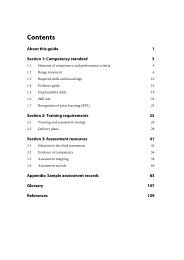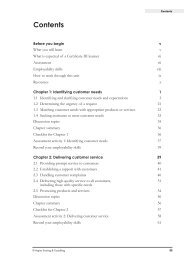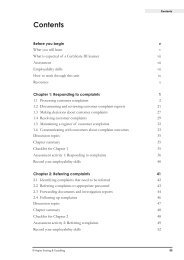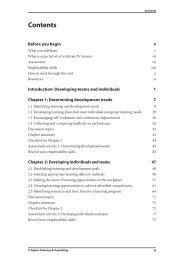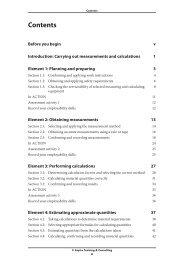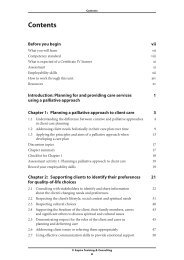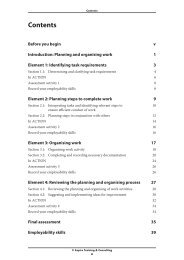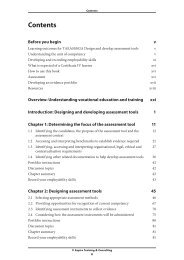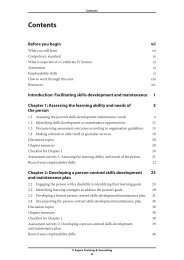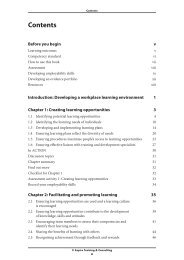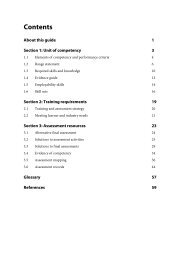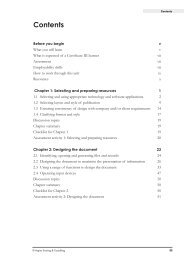Contents - Aspire Learning Resources
Contents - Aspire Learning Resources
Contents - Aspire Learning Resources
You also want an ePaper? Increase the reach of your titles
YUMPU automatically turns print PDFs into web optimized ePapers that Google loves.
<strong>Contents</strong><br />
About this guide 1<br />
Section 1: Unit of competency 3<br />
1.1 Elements of competency and performance criteria 4<br />
1.2 Range statement 6<br />
1.3 Required skills and knowledge 9<br />
1.4 Evidence guide 11<br />
1.5 Employability skills 13<br />
1.6 Skill sets 16<br />
1.7 Recognition of prior learning (RPL) 17<br />
Section 2: Training requirements 19<br />
2.1 Training and assessment strategy 20<br />
2.2 Delivery plans 23<br />
Section 3: Assessment resources 33<br />
3.1 Alternative final assessment 34<br />
3.2 Solutions to assessment activities 37<br />
3.3 Solutions to final assessments 50<br />
3.4 Evidence of competency 59<br />
3.5 Assessment mapping 61<br />
3.6 Assessment records 70<br />
Glossary 81<br />
References 83
Section 1:<br />
Unit of competency<br />
The CHC08 Community Services Training Package was developed by the Community Services and<br />
Health Industry Skills Council in consultation with industry stakeholders including employers, unions,<br />
peak bodies, professional associations, regulatory bodies, registered training organisations (RTOs) and<br />
other relevant parties. The training package specifies the skills and knowledge required to perform<br />
effectively in the workplace.<br />
Individual units of competency are nationally agreed statements that describe work outcomes and can<br />
stand alone when applied in the workplace.<br />
This section outlines the requirements of the unit of competency CHCRH406A Apply knowledge of<br />
human behaviour in leisure activity programs plus other information relevant to it.<br />
It contains the following information:<br />
1.1 Elements of competency and performance criteria<br />
1.2 Range statement<br />
1.3 Required skills and knowledge<br />
1.4 Evidence guide<br />
1.5 Employability skills<br />
1.6 Skill sets<br />
1.7 Recognition of prior learning (RPL)<br />
© <strong>Aspire</strong> Training & Consulting<br />
3
1.7 Recognition of prior learning (RPL)<br />
Recognition of prior learning (RPL) is an assessment process that assesses an individual’s non-formal<br />
and informal learning to determine the extent to which that individual has achieved the required<br />
learning outcomes, competency outcomes, or standards for entry to, and/or partial or total completion<br />
of, a qualification.<br />
To have skills and knowledge formally acknowledged, a learner must supply a range of evidence to<br />
verify competency. The trainer then needs to assess this evidence against the criteria for the<br />
qualification.<br />
Evidence of competency may include work samples, journals and third-party testimonials. Learners<br />
may also need to be observed undertaking set tasks and/or answer set questions.<br />
Sample questions that you may wish to use in an RPL interview are provided in section 3.6.<br />
© <strong>Aspire</strong> Training & Consulting<br />
17
Section 2:<br />
Training requirements<br />
To comply with the requirements of the Australian Quality Training Framework (AQTF) – superseded<br />
by the VET Quality Framework and the Standards for NVR Registered Training Organisations in<br />
some jurisdictions in July 2011 – RTOs must develop a training and assessment strategy for the<br />
training programs they deliver. The training and assessment approach adopted by an RTO must accord<br />
with the need of their learners, current industry requirements and the requirements of the training<br />
package.<br />
Trainers and assessors must make judgments about the most appropriate way to meet these<br />
requirements. These judgments should form part of the organisation’s overall training and assessment<br />
strategy.<br />
Section two contains the following information:<br />
2.1 Training and assessment strategy<br />
2.2 Delivery plans<br />
The delivery plans are accompanied by a range of PowerPoint slides, which can be adapted by trainers<br />
to suit their needs.<br />
© <strong>Aspire</strong> Training & Consulting<br />
19
2.2 Delivery plans<br />
The following delivery plans can be used to deliver CHCRH406A Apply knowledge of human<br />
behaviour in leisure activity programs. These plans, including the time allocations, are suggestions<br />
only. You may need to add to them, change them or substitute your own activities according to the<br />
interest level, experience of the learners and the specific situation. Remember; it is your responsibility<br />
as the trainer to use the most appropriate strategies for your learners.<br />
Topic: Applying knowledge of human development across the life span<br />
Suggested time allocation: 18 hours<br />
Suggested resources:<br />
Recommended reading<br />
Slide presentation software<br />
Recommended reading<br />
Slide nos: 2–8<br />
Terminology checklist<br />
<strong>Aspire</strong> learner guide CHCRH406A Apply<br />
knowledge of human behaviour in leisure<br />
activity programs<br />
Chapter 1: Applying knowledge of human<br />
development across the life span<br />
<br />
<br />
<br />
<br />
<br />
<br />
<br />
<br />
<br />
Life span<br />
Infancy<br />
Childhood<br />
Adolescence<br />
Adulthood<br />
Intellectual development<br />
Psychosocial<br />
Cognitive<br />
Morality<br />
Suggested training strategies<br />
<br />
<br />
<br />
<br />
Commence facilitation of this unit of competency by introducing learners to the <strong>Aspire</strong> learner<br />
guide CHCRH406A Apply knowledge of human behaviour in leisure activity programs.<br />
Appendix 1 to the learner guide describes the elements, performance criteria and skills and<br />
knowledge required to demonstrate competence in this unit. You may wish to discuss<br />
recognition of prior learning processes with learners at this stage.<br />
Discuss with learners the importance of identifying the employability skills that they will<br />
develop as they progress through this unit. Appendix 2 to the learner guide provides useful<br />
advice regarding employability skills. The final assessment section of the learner guide<br />
includes a template where learners may record the activities they have performed that relate<br />
to specific employability skills.<br />
Encourage learners to develop a personal glossary to record any terms that are new to them.<br />
They should record a definition and use the term in the correct context. The personal<br />
glossary could be included in a portfolio of evidence for assessment.<br />
Encourage learners to maintain a learning journal as they undertake this unit of study to<br />
record their workplace experience, reflections on their learning, feedback they receive from<br />
trainers, supervisors, consumers and their more experienced colleagues, and their selfassessment<br />
of their performance in the workplace. Advise learners whether their learning<br />
journal could form a component of their assessment in this unit. The journal could be used<br />
when undertaking practical workplace activities, but may also be used for all knowledge and<br />
skill development activities such as class assignments, tests and research tasks set by the<br />
trainer. The journal provides an opportunity for learners to demonstrate critical thinking,<br />
problem-solving and higher cognitive skills as well as providing evidence of the achievement<br />
of required knowledge and skill. <strong>Learning</strong> journal activities can encourage collaborative<br />
learning within a group and encourage learners to take responsibility for their own learning.<br />
© <strong>Aspire</strong> Training & Consulting<br />
23
3.1 Alternative final assessment<br />
Your trainer or assessor may require you to complete this assessment activity and will provide you<br />
with instructions as to how to present your responses. They may adjust the assessment activity<br />
depending on the circumstances of your training program.<br />
The following activity forms part of your assessment of competence. You may also be required to<br />
demonstrate your skills and/or provide various workplace documents or third-party reports. Your<br />
trainer will give you guidance in this area.<br />
Part Element Performance criteria<br />
A 1, 2, 3, 4 1.1, 2.1, 3.1, 3.2, 3.3, 4.1,<br />
4.4<br />
B 1, 2, 3, 4 1.2, 2.2, 2.3, 3.3, 3.4, 4.3<br />
C 3, 4 3.5, 4.2<br />
Part A<br />
1. Identify some of the key stages or changes that occur physically, socially and cognitively as a<br />
young child moves from infancy to toddlerhood. You may discuss these with your trainer/assessor<br />
or present the information in written form.<br />
2. Describe each of the following terms and give an example for each:<br />
<br />
<br />
Short-term memory<br />
Long-term memory<br />
3. What are three factors that may influence the ability to make decisions and use sound reasoning<br />
skills<br />
4. A woman is in chronic pain from osteoarthritis and has now learnt she also has breast cancer.<br />
What coping strategies and stages may you observe over time Explain your answer with<br />
reference to coping strategies and Leventhal’s model of illness behaviour.<br />
5. What was the medical model of care and when was it prevalent What concepts have replaced this<br />
model<br />
6. Identify and explain one negative response to a situation such as receiving a diagnosis of a<br />
significant mental illness.<br />
7. Briefly explain each of the following federal laws in terms of how they relate to work in leisure<br />
services:<br />
<br />
<br />
<br />
Disability Discrimination Act 1992 (Cth)<br />
Racial Discrimination Act 1975 (Cth)<br />
Privacy Act 1988 (Cth)<br />
© <strong>Aspire</strong> Training & Consulting<br />
34
Assessment activity 3<br />
Part A<br />
1. Answers may vary. The assessment candidate should have produced a professional poster suitable<br />
for display at a conference. The assessment candidate should have made reference to the five<br />
elements of the Leventhal model:<br />
<br />
<br />
<br />
<br />
<br />
Identity<br />
Cause<br />
Time line<br />
Consequences<br />
Curability/Control<br />
The assessment candidate should have made reference to practical examples of how this model<br />
may apply to a client. Here is an example of how the assessment candidate may have included this<br />
information:<br />
Identity – the assessment candidate may have given a case study where a client has a desire to<br />
identify or label their condition with a title that is meaningful for them such as arthritis or diabetes.<br />
Cause – the assessment candidate may have given examples of causes that relate to specific<br />
conditions, or may have referred to how a client may seek details of possible causes even when<br />
there is not a medical opinion available to support a causal relationship between the illness and a<br />
cause.<br />
Time line – the assessment candidate may have referred to changing time lines or how clients may<br />
find comfort in knowing how long an illness may last for or when they may begin to feel better.<br />
Consequences – the assessment candidate may have explained how understanding consequences<br />
can be helpful for clients, or they may have given information about how a leisure and health<br />
worker can support client understanding by providing or reinforcing knowledge in an appropriate<br />
way.<br />
Curability/control –the assessment candidate may have referred to the desire of many clients to<br />
feel in control of their illness or to take charge of elements of their own care. The assessment<br />
candidate may have given examples such as retaining control of medication management, being<br />
actively involved in developing care plans or seeking to direct their own activities.<br />
2. Answers may vary. The assessment candidate should have given pre- and post-intervention<br />
comments or suggestions. The assessment candidate may have referred to<br />
<br />
Pre intervention – taking anecdotal notes or keeping records about how the clients perceive<br />
their activity habits, food and drinks eaten during a typical day, and their consumption of fresh<br />
fruit and vegetables or junk food. The clients may also be asked about how healthy they<br />
believe they are, or whether they think any of their actions might be a sign of poor health<br />
behaviours. The assessment candidate may have included ideas about how to modify the<br />
assessment phase to suit the cognitive skills of the clients such as by using graphic or pictorial<br />
information. The assessment candidate may have used a formal questionnaire or tool to<br />
conduct their pre-intervention assessment.<br />
© <strong>Aspire</strong> Training & Consulting<br />
43
so James would do better with short, easy questions rather than long complex ones. He would<br />
need to use a name badge and provide gentle reminders during the activity if required.<br />
2. Some of the clients may be moving towards moderate dementia stages, and so may not be able to<br />
understand the quiz or may have difficulty with its duration. They may be from a cultural<br />
background where Dickens is not well known, and this could also make the language of the film<br />
and quiz challenging. There may be words and phrases that are not familiar to some of the clients.<br />
Some clients may not have enjoyed reading when they were younger and so are not likely to enjoy<br />
a reading-based activity now.<br />
3. James could plan activities such as cooking, art and craft tasks, walking in a local park, preparing<br />
a BBQ or doing some simple gardening tasks in a sensory garden outdoors. He would need to<br />
ensure all clients are able to participate in the activities safely and would also need to monitor use<br />
of equipment and art supplies to ensure they are used safely and appropriately. If he was taking the<br />
group out of the centre, it is likely he would need some additional staff support to increase the<br />
staff–client ratio.<br />
4. Activities that may be suitable for the client with the ABI from a car accident include exercise<br />
activities, art and craft, movies, music, gardening, woodwork, one-to-one leisure activities away<br />
from the centre such as fishing from a pier. The activities could be planned to allow for increases<br />
in skill over time, whereas the clients with dementia will deteriorate in their memory and cognitive<br />
skills over time.<br />
5. James should consult his workplace policies manual and talk with his supervisor about suitable<br />
strategies. These may include bringing in another staff member to help with activities or having<br />
the client attend only for part of the session. He would need to identify specific risks and consider<br />
how to manage them. For example, he could develop a plan for dealing with a situation where the<br />
client attempted to harm him or another client. He should have the right to refuse the client as he<br />
has rights under work health and safety legislation, although these rights would need to be<br />
balanced against the client’s rights under the Disability Discrimination Ac 1992 (Cth).<br />
6. If James is only working with adult clients there is no requirement for him to have a Working with<br />
Children Check. The check only relates to ongoing, regular work done with children.<br />
7. The woman may show aggressive behaviour as part of an illness perception response, as suggested<br />
by Leventhal in relation to ‘cause’. She may feel some guilt that she has caused her own ABI<br />
through excessive drinking of alcohol and this could be the reason for her inappropriate behaviour,<br />
with aggression shown towards other people.<br />
8. The problem with the term is that it is demeaning and insulting for the clients, and does not use<br />
person-first language. It should be expected that anyone working in the sector would use personfirst<br />
terms, with the client placed first in the sentence. For example, ‘This is the group of clients<br />
who participate in activities at the centre. These clients have been diagnosed with dementia.’ This<br />
places the clients first and their dementia second in importance. The phrase about ‘the best they<br />
can’ is really not necessary and is also belittling and so could be deleted altogether, although the<br />
learner may choose to leave this second part in without it necessarily being considered incorrect.<br />
© <strong>Aspire</strong> Training & Consulting<br />
51
Gathering evidence<br />
Evidence can be gathered through:<br />
<br />
<br />
real work/real-time activities through observation and third-party reports<br />
structured activities.<br />
Evidence can also be gathered through:<br />
<br />
<br />
formative assessments: where assessment is progressive throughout the learning process and<br />
validated along the way by the trainer – also known as assessment for learning<br />
summative assessment: where assessment is an exercise or simulation at the end of the learning<br />
process – also known as assessment of learning.<br />
Evaluating evidence<br />
The following steps may help you evaluate evidence.<br />
Step 1: Evidence is gathered.<br />
Step 2: Rules of evidence are applied – evidence is valid,<br />
sufficient, current and authentic.<br />
Step 3: Evidence meets the full requirements of the unit/s of<br />
competency.<br />
Step 4: The assessment process is valid, reliable, fair and flexible.<br />
Step 5: The trainer or assessor makes a straightforward and informed judgment about<br />
the candidate and completes assessment records.<br />
© <strong>Aspire</strong> Training & Consulting<br />
60
Recognition of prior learning (RPL) interview questions<br />
The following questions are designed to assist trainers/assessors through the RPL interview process.<br />
These questions will help trainers/assessors assess the required knowledge.<br />
1. Explain what you know about the cognitive, psychosocial, moral and physical development of<br />
human beings over the various life stages.<br />
2. How could you apply your knowledge of human development to work with clients in a leisure<br />
situation<br />
3. Give a brief description of conditions that cause impaired cognition, such as dementia (including<br />
Alzheimer’s disease, acquired brain injury, Huntington’s disease, Parkinson’s disease, Pick’s<br />
disease, schizophrenia and stroke.<br />
4. What are some of the factors that can affect memory and decision-making Explain three of these<br />
in detail.<br />
5. Describe how you would plan and implement a recreation/leisure activity for a group of clients<br />
who had early stage dementia.<br />
6. Explain Leventhal’s model of illness behaviour (also known as the self-regulatory model or the<br />
common-sense model), and how this model informs practice in the leisure and health sector.<br />
7. Discuss the impact that negative client behaviour such as aggression and violence can have on<br />
direct care workers, supervisor staff and family members (primary caregivers).<br />
8. Give an example of non-inclusive language being used – you may choose to explain or write an<br />
example, or locate one in a print or electronic text.<br />
9. Describe how positive and negative attitudes towards people with disabilities can impact on the<br />
person, and affect their ability to participate in community-based activities.<br />
10. How could you facilitate the inclusion of a client with a disability into a leisure activity<br />
11. List at least three pieces of Australian legislation that impact on leisure service delivery, and<br />
explain how each one relates to your daily work practices.<br />
© <strong>Aspire</strong> Training & Consulting<br />
75



